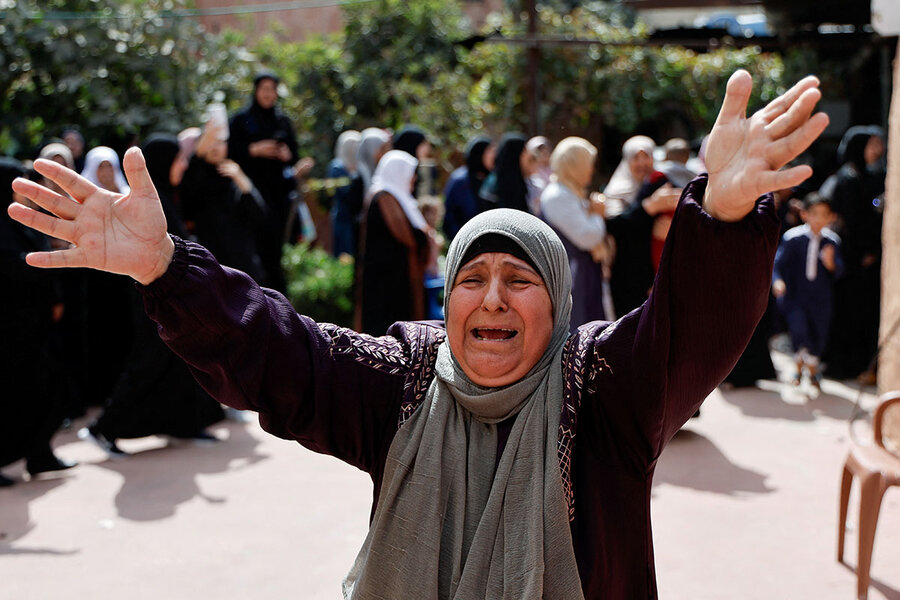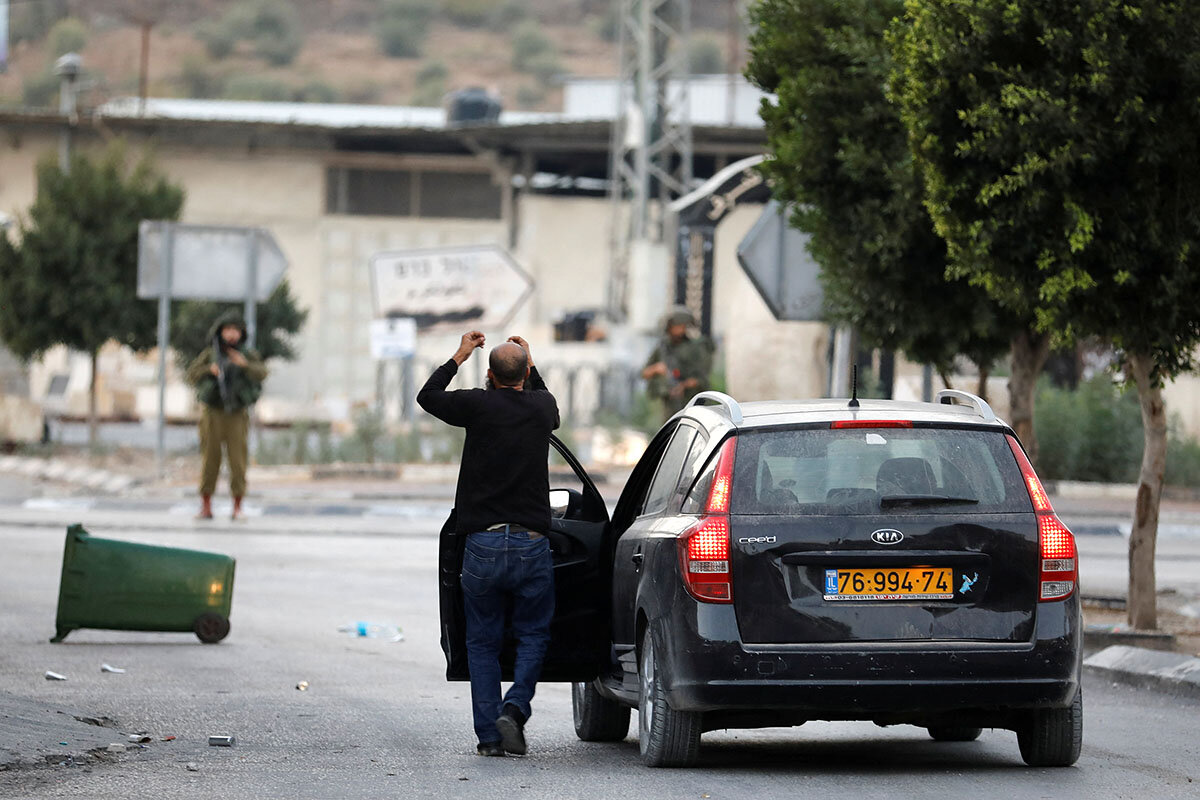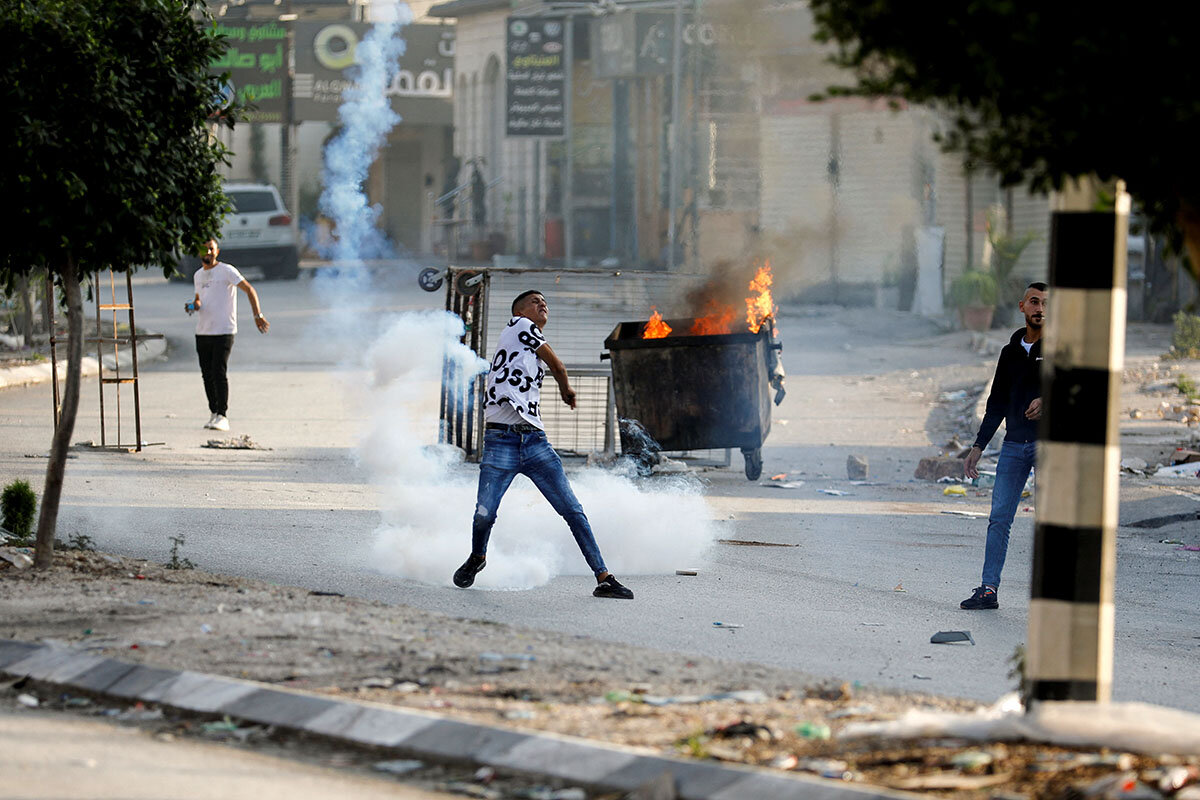As world watches Gaza, West Bank sees most violent month in decades
Loading...
| RAMALLAH and JERICHO, West Bank
Israeli military raids in towns and villages, checkpoints on the roads, the threat of settler attacks at any moment – Palestinians across the occupied West Bank say they now face potentially deadly violence every few hours.
Amid Israel’s tightened military crackdown here in the West Bank – part of its security response to the Oct. 7 Hamas attack from Gaza – this occupied territory has endured its deadliest month in two decades.
The violence has disrupted Palestinians’ daily lives and created a foreboding environment in which a life-or-death situation or obstacle may be just around the corner.
Why We Wrote This
A story focused onCrackdowns by Israeli authorities and the proliferation of security checkpoints have transformed life in the West Bank, and young Palestinians in particular are struggling to navigate new, dangerous territory.
“We are not under missiles like Gaza or in a war, but there is no safe space in the West Bank either, even when it’s calm,” says Mohammed, whose Ramallah home was stormed by Israeli forces last week in search of a suspect.
“Since Oct. 7, we have gone from an occupation to complete domination,” he says.
According to the United Nations Office for the Coordination of Humanitarian Affairs, the Israel Defense Forces killed 147 Palestinians across the West Bank from Oct. 7 to Nov. 8, including 44 children – more than in all of 2022. The U.N. reports that eight additional Palestinians, including one child, were killed in the West Bank by settlers. Clashes and Israeli military raids on Wednesday and Thursday pushed the West Bank death toll to 181, the Palestinian Health Ministry said.
A series of scattered attacks by Palestinian gunmen on settlements and Israeli outposts killed one Israeli reserve soldier on leave in the northern West Bank last week and injured two settlers with gunshot wounds late Wednesday.
Wide-ranging Israeli raids have arrested 2,200 Palestinians across the West Bank as of Thursday, in what the Israel Defense Forces says are preemptive arrests of militants and cells planning attacks.
Palestinian officials, activists, and families say the crackdown has also arrested moderate Fatah leaders, student activists, and average citizens whose relatives say their only perceived threat was posting about the Israel-Hamas war on social media. Those detained are being held in undisclosed locations with little information available to families or lawyers, families say.
Palestinians say they feel surrounded by all sides, at all times.
“We are being suffocated by the occupation, Israeli military raids, by checkpoints and now settlers,” says Hussein, a university student in Ramallah, who felt safe having only his first name in print. “It’s like breathing is a crime.”
The most visible symbols of this remilitarized life in the West Bank are checkpoints.
“This is collective punishment”
Since Oct. 7, old Israeli checkpoints and roadblocks from the second intifada have been revived; hastily piled earthen berms now cover central roads leading into Ramallah and other towns.
Post-Oct. 7 checkpoints feature concrete blocks and shiny new yellow gates.
Israeli flags now hang from overpasses and fly from checkpoint blocks, poles, and towers on roads linking West Bank towns and villages. One can be forgiven if they think they are driving in Israel.
Back in August, the Office for the Coordination of Humanitarian Affairs counted 645 physical obstacles and checkpoints in the West Bank and East Jerusalem, an 8% increase from January. Since Oct. 7, the office has documented dozens of additional checkpoints across the West Bank.
At the entrances and exits to Jericho, the only point of entry for Palestinians, visitors, and cargo from Jordan into the West Bank, checkpoints erected in February are now fully manned. Every single vehicle is inspected, slowing traffic to hourslong waits.
“Last check: Everybody, erase your photos!” taxi driver Abu Abed calls to three passengers as they near the checkpoint after a two-hour wait. He says this is what now counts as “an open road on a good day.”
“The first thing we do each morning is erase the photos and videos on our phones,” explains Abu Abed, who, like others in this story, goes by a teknonym, a common practice referring to people by the names of their children, to protect his safety. “If there is any photo or video of victims in Gaza, or any video shared in a WhatsApp group purporting to be from Hamas or showing the war, you’re going to jail,” he says, noting two of his fellow drivers have been arrested.
At West Bank checkpoints, Israeli security personnel spend several minutes inspecting passengers’ phones.
“This is collective punishment,” says driver Abu Yassin, whose Ramallah-Saffa route now goes through multiple checkpoints that can make a 40-minute commute take half a day. “With these checkpoints, the Israelis are punishing every woman, child, and man who have nothing to do with militants, who are just trying to go about their lives and go to school, work, and get health care on what is supposed to be their land.”
Mohammed Abu Yusuf’s vegetable shop at the edge of Birzeit, a town north of Ramallah, is now sandwiched between two checkpoints.
A previously abandoned watchtower from the second intifada 50 meters uphill from his shop is now manned by the Israeli military, closing off the road. A new checkpoint has been erected 50 meters down from his shop on the main road. Settlers attacked his shop last week.
“We are worried that increased interaction with the Israeli military and settlers means we could be shot and killed any day,” Mr. Abu Yusuf says. “But what can we do? We have to try to live.”
History repeating
Veterans of the second intifada – in which 6,371 Palestinians and 1,083 Israelis were killed, spurring Israel’s erection of the hulking concrete barrier along much of the Israel-West Bank border – recognize the dynamic.
But for those born around or after the 2001 uprising, who have no memory of the Israeli military occupation and incursions at that time, it has been a shock. According to the U.N., 30% of Palestinians in the West Bank and Gaza are under the age of 20 and half are under the age of 29.
“I have never seen anything like this,” 18-year-old Mashur Zaher says as he unloads a vegetable delivery. “Checkpoints everywhere and Israeli tanks entering villages were stories I heard from my parents and older brothers, but I thought that was history. I never thought it would happen again, and happen to me.”
Checkpoints and settler attacks have forced West Bank universities to close campuses and switch to remote learning. Several international organizations and businesses have instructed West Bank employees to work from home, implementing pandemic protocols.
Some young Palestinians have responded with protests and riots, leading to deadly confrontations with the Israeli military.
One such flashpoint is a grouping of roadblocks and a manned Israeli checkpoint at the northern entrance to Al-Bireh, a main entry point into Ramallah, the West Bank capital, enforced after Oct. 7.
The road is littered with burn marks from burnt tires and Molotov cocktails from nighttime clashes.
In this pressured environment, events can escalate quickly even in the sleepiest and calmest of West Bank neighborhoods.
A reported Israeli military raid on an apartment building in Al-Bireh last Thursday to arrest two university students ended in violence when local youths allegedly threw rocks at the Israeli military jeeps, prompting Israeli forces to open fire, killing one young Palestinian man and a 14-year-old boy.
“Even when you are sitting at home minding your own business, the conflict comes to you,” says Umm Mohammed, a resident who watched the raid. “We avoid checkpoints, avoid travel between towns, and now avoid going out at night. And the violence and the Israelis still come to us.”
U.N. Under-Secretary-General for Humanitarian Affairs Martin Griffiths warned Thursday that “we cannot lose sight of the deteriorating situation in the West Bank,” where incidents of violence “are the worst they have been in years.”
Palestinian officials are more blunt.
“Anyone who thinks the West Bank will remain calm and quiet under all these obstructions, arrests, attacks, and deaths,” says senior Palestinian Authority official Ahmed Majdalani, “is either delusional or stupid.”







